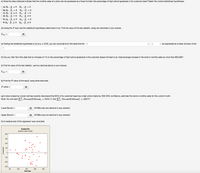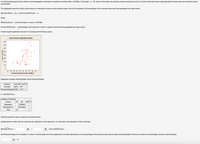
MATLAB: An Introduction with Applications
6th Edition
ISBN: 9781119256830
Author: Amos Gilat
Publisher: John Wiley & Sons Inc
expand_more
expand_more
format_list_bulleted
Concept explainers
Topic Video
Question
R-Studio. Thank you in advance!

Transcribed Image Text:(c) Does the data collected indicate that the monthly sales of a store can be expressed as a linear function the percentage of high school graduates in its customer base? Select the correct statisticaly hypotheses.
А. Но : В1
В. Но : В — о На : В >0
C. Ho : B1 20 HẠ : B1 > 0
D. Ho : B1 = 0 HẠ : B1 + 0
E. Ho : B1 2 0 HẠ: B1 < 0
F. Ho : B1 > 0 HẠ : B1
0 HA : B1 < 0
(d) Using the F-test, test the statistical hypotheses determined in (c). Find the value of the test statistic, using two decimals in your answer.
Feale
%3D
(e) Testing the statistical hypotheses in (c) at a = 0.05, you can conclude from this data that the
?
?
v be expressed as a linear function of the
?
(f) Can you infer from this data that an increase of 1% to the percentage of high school graduates in the customer based will lead to an mean/average increase in the store's monthly sales by more than $50,000?
(i) Find the value of the test statistic, use two decimal places in your answer.
Tcalc
...
(ii) Find the P-value of the result, using three decimals.
P-value =
(g) A store located at a local mall has recently discovered that 90% of its customer base has a high school diploma. With 95% confidence, estimate this store's monthly sales for the current month.
38
38
Note: You will need E, Percent HSGrads; = 2935.17 and E, Percent H SGrads
= 228777
i=1
i=1
Lower Bound =
$1000s (use one decimal in your answer)
Upper Bound =
$1000s (use one decimal in your answer)
(h) A residual plot of the regression was consulted.
Residual Plot
(Response is Sales in $1000s)
2000
1500
1000 -
500 -
-500 -
-1000
-1500
500
1000
1500
2000
2500
Fitted Value
O O
Residual

Transcribed Image Text:A national sporting good store wishes to use demographic information to predict its monthly sales, in $1000s. Thrity-eight, n =
38, stores of the chain are randomly chosen across the country. It is known that each store is approximately the same size and carries the same
merchandise.
The geographic area from which a store draws its customers is known as the customer base. One of the variables is the percentage of the customer base who have graduated from high school.
MonthlySales; = Bo + Bị Percent H SGrads; + e;
where
MonthlySales;
- is the total sales in month i, in $1000s
Percent H SGrads; - is percentage of all customers in store i customer base that have graduated from high school
A least-squares regression was ran in R producing the following output:
Scatter Plot: Sales to High School Graduates
4000 -
3500
3000 -
2500 -
2000
1500-
1000 -
500 -
0-
50
55
60
65
70
75
80
85
90
95
Percentage of Customer Base with a HS Diploma
Regression Analysis: MonthlySales versus PercentHSGrads
Predictor
Coef SD Coef TP
Constant
|-2970
1371
PercentHSGrads 59.66 17.67
S = 802.004 R-Sq =
%3D
Analysis of Variance
Source
DF
S
MS FP
Regression
7333350
Residual Error
23155564
Total
37
Using the partial R output, answer the questions below.
(a) Estimate the model. Use two-decimals your estimation of the slope term, no decimals in the estimation of the y-intercept.
MonthlySales; :
Percent H SGrads;
+
(b) What percentage of the variation in a store's monthly sales cannot be explained by its linear dependency on the percentage of the customer base that are high school graduates? Enter your answer as a percentage, using two decimal places.
%
Sales in $1000s
Expert Solution
This question has been solved!
Explore an expertly crafted, step-by-step solution for a thorough understanding of key concepts.
This is a popular solution
Trending nowThis is a popular solution!
Step by stepSolved in 2 steps

Knowledge Booster
Learn more about
Need a deep-dive on the concept behind this application? Look no further. Learn more about this topic, statistics and related others by exploring similar questions and additional content below.Similar questions
- The members of Mrs. Grant’s class are given a number and standing in a circle; they are evenly spaced and are numbered in order. The student with number 7 is standing directly across from the student with number 17. How many students are in the class?arrow_forwardHow many instructions do i need in all?arrow_forwardClayton dies without a will leaving an estate of $350,000. Clayton's heirs consist of his wife and two children. His state requires that in the absence of a will , each child is to receive 2/3's as much as a spouse. How much will each of them receive? Answer from the back of the book: Wife = $150,000 each child: $100,000arrow_forward
- Bananas cost $0.50 each, and apples cost $1.00 each. Select all the combinations of bananas and apples that Elena could buy for exactly $3.50. 2 bananas and 2 apples 1 banana and 2 apples 3 bananas and 2 apples 1 banana and 3 apples 5 bananas and 2 apples 5 bananas and 1 applearrow_forwardFind the first 5 terms a1 = 9; d = -2arrow_forwardPlease help me answer the following questions. Thank youarrow_forward
arrow_back_ios
arrow_forward_ios
Recommended textbooks for you
 MATLAB: An Introduction with ApplicationsStatisticsISBN:9781119256830Author:Amos GilatPublisher:John Wiley & Sons Inc
MATLAB: An Introduction with ApplicationsStatisticsISBN:9781119256830Author:Amos GilatPublisher:John Wiley & Sons Inc Probability and Statistics for Engineering and th...StatisticsISBN:9781305251809Author:Jay L. DevorePublisher:Cengage Learning
Probability and Statistics for Engineering and th...StatisticsISBN:9781305251809Author:Jay L. DevorePublisher:Cengage Learning Statistics for The Behavioral Sciences (MindTap C...StatisticsISBN:9781305504912Author:Frederick J Gravetter, Larry B. WallnauPublisher:Cengage Learning
Statistics for The Behavioral Sciences (MindTap C...StatisticsISBN:9781305504912Author:Frederick J Gravetter, Larry B. WallnauPublisher:Cengage Learning Elementary Statistics: Picturing the World (7th E...StatisticsISBN:9780134683416Author:Ron Larson, Betsy FarberPublisher:PEARSON
Elementary Statistics: Picturing the World (7th E...StatisticsISBN:9780134683416Author:Ron Larson, Betsy FarberPublisher:PEARSON The Basic Practice of StatisticsStatisticsISBN:9781319042578Author:David S. Moore, William I. Notz, Michael A. FlignerPublisher:W. H. Freeman
The Basic Practice of StatisticsStatisticsISBN:9781319042578Author:David S. Moore, William I. Notz, Michael A. FlignerPublisher:W. H. Freeman Introduction to the Practice of StatisticsStatisticsISBN:9781319013387Author:David S. Moore, George P. McCabe, Bruce A. CraigPublisher:W. H. Freeman
Introduction to the Practice of StatisticsStatisticsISBN:9781319013387Author:David S. Moore, George P. McCabe, Bruce A. CraigPublisher:W. H. Freeman

MATLAB: An Introduction with Applications
Statistics
ISBN:9781119256830
Author:Amos Gilat
Publisher:John Wiley & Sons Inc

Probability and Statistics for Engineering and th...
Statistics
ISBN:9781305251809
Author:Jay L. Devore
Publisher:Cengage Learning

Statistics for The Behavioral Sciences (MindTap C...
Statistics
ISBN:9781305504912
Author:Frederick J Gravetter, Larry B. Wallnau
Publisher:Cengage Learning

Elementary Statistics: Picturing the World (7th E...
Statistics
ISBN:9780134683416
Author:Ron Larson, Betsy Farber
Publisher:PEARSON

The Basic Practice of Statistics
Statistics
ISBN:9781319042578
Author:David S. Moore, William I. Notz, Michael A. Fligner
Publisher:W. H. Freeman

Introduction to the Practice of Statistics
Statistics
ISBN:9781319013387
Author:David S. Moore, George P. McCabe, Bruce A. Craig
Publisher:W. H. Freeman